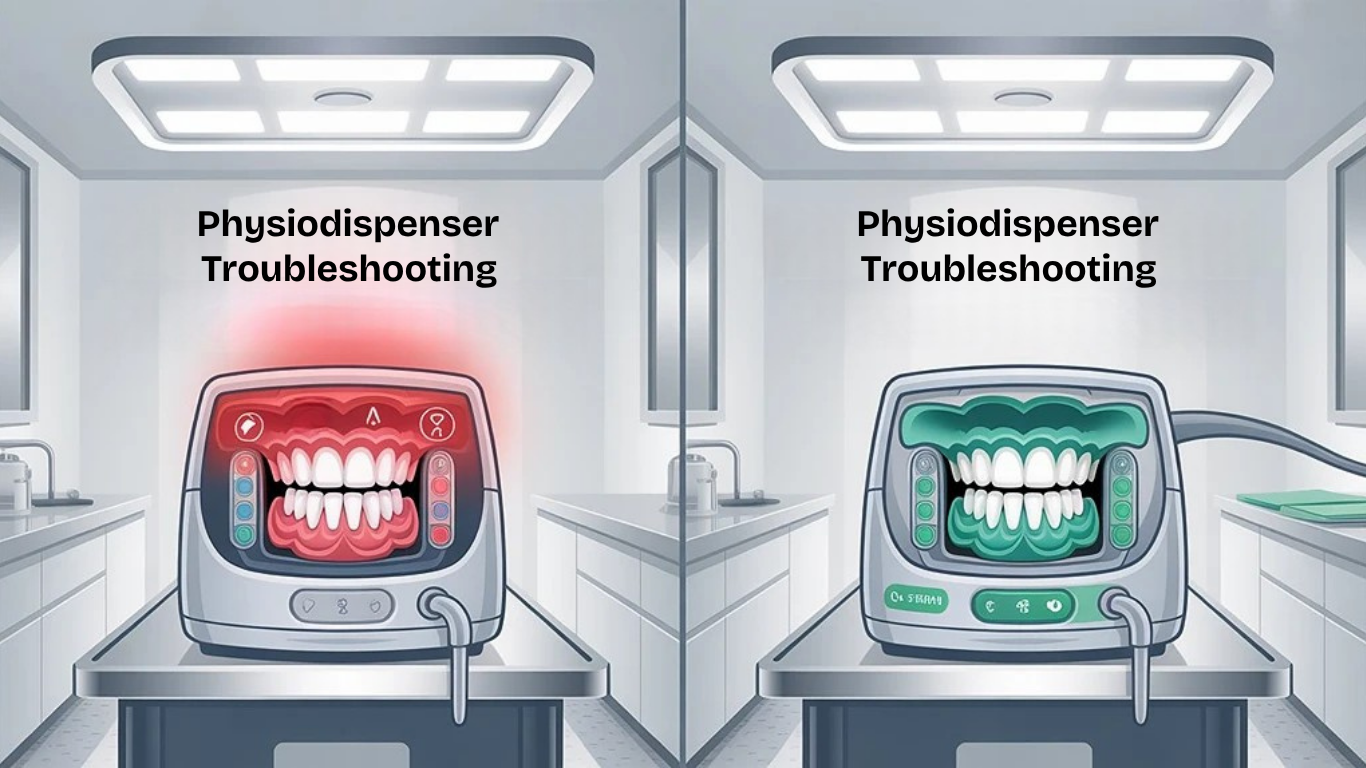
Common Physiodispenser Problems and How to Fix Them
If you use a physiodispenser regularly, you already know one thing when it acts up, it always happens at the worst possible time. You’re in the middle of an implant surgery, the patient is numb and waiting, and suddenly the motor refuses to cooperate.
Most dentists panic at that moment.
But the truth is: many of these issues are small, routine, and fixable right inside your clinic.
This guide is written exactly for those moments. Simple explanations, real-life causes, and easy fixes.
Motor Suddenly Not Starting
This is the most common complaint I hear from colleagues about physiodispenser.
Why it happens:
- A cable isn’t sitting properly
- Foot pedal not connected
- Motor overheated and went into protection mode
- Loose plug at the wall socket
Quick Fix:
- Unplug and reattach everything gently but firmly.
- Try another wall socket just to rule it out.
- If the motor feels warm, give it a few minutes.
- Check the pins on the motor cord. Even a slightly bent pin stops the connection.
Personal tip:
Most “faulty motor” calls I get end up being a loose cable.
RPM or Torque Feels Weak
You press the pedal and the motor feels… tired.
This usually isn’t the motor it’s the contra-angle or settings.
Possible reasons:
- Contra-angle nearing service time
- Wrong gear ratio selected
- Torque accidentally changed
- Lubrication overdue
What to do:
- Match the gear ratio (mostly 20:1).
- Reset torque and RPM to your usual numbers.
- Try another contra-angle.
- Clean and lubricate according to the brand guidelines.
A tired contra-angle can make even a good implant motor feel weak.
Water Flow Issues (Probably the Most Annoying One)
Either too slow… or nothing comes out at all.
Why this happens:
- Tubing is bent somewhere
- Air bubble stuck in the line
- Bottle placed too low
- Tubing blocked by debris
Fix:
- Straighten the water line from top to bottom.
- Let the pump run for 10–15 seconds to clear air.
- Keep the irrigation bottle slightly elevated.
- Change or clean the tubing.
Important:
Good irrigation is the only thing preventing bone overheating during drilling.
Motor or Contra-Angle Heating Up
Heat during implant drilling is never a good sign.
Why it happens:
- Long continuous drilling
- Poor water flow
- High RPM for the drill being used
- Old bearings inside the contra-angle
Fix:
- Drill in short, controlled bursts.
- Make sure water flow is strong.
- Stick to recommended RPM.
- Replace or service the contra-angle if heat is new or sudden.
Foot Pedal Not Responding
This one scares dentists because mid-surgery it feels like the whole unit has died.
Possible reasons:
- Broken cable
- Dust or moisture inside
- Internal switch failure
Fix:
- Test with another pedal (if available).
- Clean around the pedal using compressed air.
- Replace the cable if it looks worn.
If nothing works, the pedal usually needs a service—don’t force it.
Error Codes Popping Up Randomly
Every brand uses different codes, but the meaning is usually one of these:
- Motor strain
- Calibration issue
- Software glitch
- Sensor problem
Fix:
- Switch OFF → wait → switch ON
- Reset settings (if allowed)
- Check manual for code meaning
- If the error repeats, call service. Sensor issues rarely fix themselves.
Strange Noise or Vibration
A physiodispenser should feel smooth. If you hear rattling or vibration, something is off.
Why it happens:
- Drill is bent
- Chuck is loose
- Bearings worn
- Contra-angle misaligned
Fix:
- Replace the drill first.
- Tighten the chuck.
- If noise continues, get the contra-angle serviced.
Never continue drilling if you feel vibration it compromises the osteotomy.
When It’s Time to Call a Technician
Some issues should not be handled at the clinic, such as:
- Burning smell
- Water leaking inside the unit
- Repeated overheating
- Display flickering
- Motor shutting off frequently
Stopping the surgery is safer than forcing the machine.
How to Avoid Most Problems Altogether
Here’s what actually works (learned from experience):
- Service the unit once a year
- Keep tubing clean and replace when needed
- Lubricate contra-angles regularly
- Store the motor in a dry place
- Avoid cheap aftermarket cables
Small habits → big difference in performance.
Conclusion
A physiodispenser is one of those tools that silently carries the weight of every implant surgery. When it works well, everything else falls into place. Most problems aren’t serious they just need a quick look and a little understanding.
With the right troubleshooting, you can avoid panic, save time, and keep your implant workflow smooth and predictable.
👉 Shop for dental products with Shop4Smile – powered by ABA Technologies.

Leave a Reply